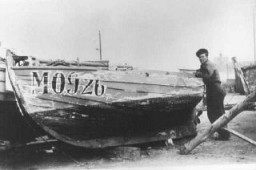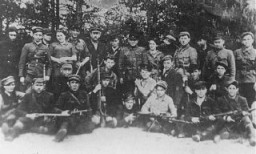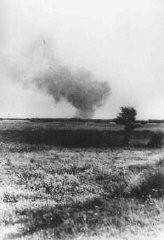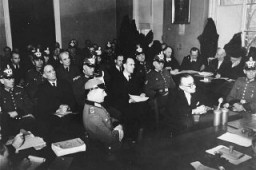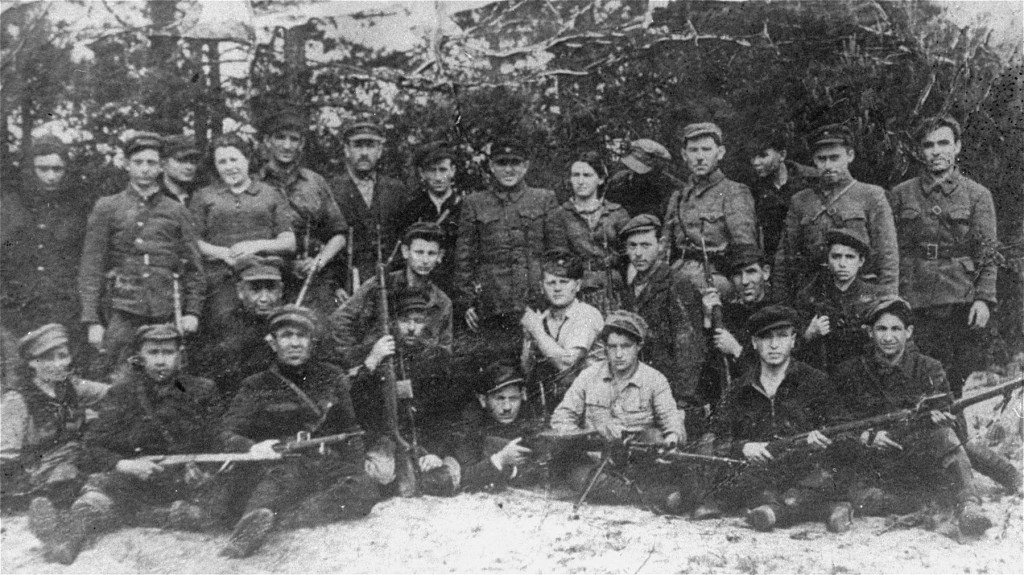
Jewish Partisans
Jewish Partisans Some Jews who managed to escape from ghettos and camps formed their own fighting units. These fighters, or partisans, were concentrated in densely wooded areas. A large group of partisans in occupied Soviet territory hid in a forest near the Lithuanian capital of Vilna. They were able to derail hundreds of trains and kill over 3,000 German soldiers.
Life as a partisan in the forest was difficult. People had to move from place to place to avoid discovery, raid farmers' food supplies to eat, and try to survive the winter in flimsy shelters built from logs and branches. In some places, partisans received assistance from local villagers, but more often they could not count on help, partly because of widespread antisemitism, partly because of people's fears of being severely punished for helping. The partisans lived in constant danger of local informers revealing their whereabouts to the Germans.
Many Jews participated in the partisan units formed in France and Italy to help regular Allied forces defeat German forces. They forged documents and identity cards, printed anti-Nazi leaflets, and assassinated collaborators.
Twenty-three-year-old Hannah Szenes, a Hungarian Jew who emigrated to Palestine in 1939, was one of the thirty-two Palestinian parachutists the British dropped behind German lines to organize resistance and rescue efforts. Before crossing the border in Hungary on June 7, 1944, to warn Hungarian Jews about the extermination camps, Szenes, a poet, handed a poem to one of her companions. It ended with these lines: "Blessed is the heart with strength to stop its beating for honor's sake. Blessed is the match consumed in kindling flame." Szenes was captured the next day and executed as a traitor to Hungary.
Key Dates
July 20, 1941
Ghetto ordered in Minsk, sparks resistance
On July 20, 1941, the Germans order the establishment of a ghetto in Minsk. Within days of the ghetto's establishment, thousands of Jews are killed. Jews in the ghetto form an underground resistance network in August 1941. Members of the underground set up a printing press and newspaper to distribute information to the ghetto population. The underground also contacts partisan units outside the ghetto to find hiding places for Jews in the ghetto. In March 1942, the Germans carry out an action in the Minsk ghetto in which thousands are killed. Shortly thereafter, members of the underground begin leaving the ghetto for the forests where they form partisan units and fight the Germans. The partisans in the forests work to rescue Jews from the ghetto and bring them to the forests, where they establish partisan bases. Approximately 10,000 Jews flee the Minsk ghetto for the forests by 1944. Many lose their lives in the attempt.
January 1942
Jewish Army in France
The Jewish Army (Armee Juive; AJ), is established by Zionist youth groups in Toulouse, France. The AJ operates throughout France, but is particularly active in the southern regions. Members are recruited from both Jewish and non-Jewish youth and resistance groups and are trained in military and sabotage activities. AJ members smuggle money out of Switzerland to France to distribute to Jewish relief agencies. This money helps thousands of Jews in hiding. The AJ assassinates some of those who cooperate with the Germans and smuggles about 500 Jews and non-Jews across the border into neutral Spain. In 1943 and 1944, the AJ establishes close ties with Allied forces—including General Charles de Gaulle's Free French of the Interior (FFI) forces. In 1944, during the liberation of France, the AJ participates in uprisings in Paris, Lyon, and Toulouse against the German occupation.
January 21, 1942
United Partisan Organization in Vilna
After reports of mass killings of Jews at Ponary, outside Vilna, members of Zionist youth movements establish the United Partisan Organization (Fareynegte Partizaner Organizatsye, FPO) in the Vilna ghetto. The organization prepares to resist the Germans in the event that the ghetto is threatened with destruction and establishes contact with other ghettos to acquire weapons and encourage resistance. In early September 1943, the Germans deporting Jews from the ghetto and are confronted with resistance by FPO members. The FPO decides to abandon the ghetto and flee to the nearby forests to fight the Germans from the outside. The last group of resistance fighters escapes the final destruction of the ghetto on September 23, 1943. They leave the ghetto through the sewers and join partisans in the Rudninkai and Naroch forests.

